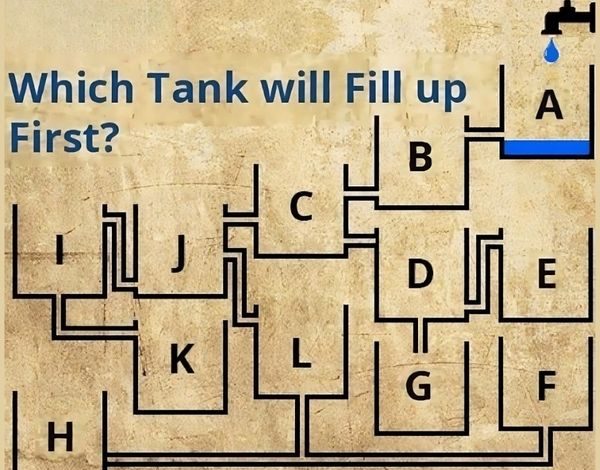The Puzzle of Flow: Which Tank Will Fill Up First?

ADVERTISEMENT
The Puzzle of Flow: Which Tank Will Fill Up First?
Introduction
Puzzles have long been a favorite pastime for those who enjoy testing their logic and problem-solving skills. Among the many types of puzzles, flow puzzles, like the one you’ve shared, stand out for their ability to challenge our understanding of systems and sequences. The question posed in the image—“Which tank will fill up first?”—requires careful observation and logical reasoning. Let’s dive into the mechanics of this puzzle and explore the solution.
Analyzing the Puzzle
At first glance, the puzzle seems simple: water flows from a tap into a series of interconnected tanks. The goal is to determine which tank will fill up first. However, upon closer inspection, the puzzle reveals its complexity. Not all tanks are equally accessible to the water, and some pathways are blocked, which prevents certain tanks from filling up immediately.
Step-by-Step Breakdown
ADVERTISEMENT
To solve this puzzle, let’s trace the flow of water from the source (Tank A) through the interconnected channels:
- Tank A: Water starts at Tank A and begins to flow downward.
- Tank B: As water flows into Tank B, it continues downward. However, the exit to Tank C is blocked, preventing water from flowing into Tank C.
- Tank D: Water flows from Tank B into Tank D. Here, we must carefully observe the channels:
- The path to Tank E is blocked.
- Water continues to flow downward into Tank G.
- Tank G: Water fills Tank G next. At this point, there are no blocked pathways, so Tank G will continue to fill up without any interruptions.
The Solution
Given the flow and blocked paths, Tank G is the first tank that will fill up completely. Other tanks either have blocked paths or are dependent on the filling of previous tanks before they can begin to fill, making Tank G the most direct recipient of the water flow.
Understanding the Logic
The key to solving this puzzle lies in understanding the system of blocked and unblocked pathways. The tanks with blocked exits will either never fill or will only fill after the water level has risen high enough to bypass the blockage. This type of puzzle teaches us the importance of considering all variables in a system before arriving at a conclusion.
ADVERTISEMENT
Conclusion
Flow puzzles like this one offer more than just a challenge—they offer insight into how systems work and how different components interact within those systems. By analyzing the paths water can take and identifying where it will be blocked or rerouted, we can accurately predict outcomes that might not be immediately obvious.
In this particular puzzle, Tank G is the first to fill, demonstrating that the shortest and least obstructed path is often the quickest way to reach a solution. Whether used as a brain exercise or just for fun, these puzzles remind us that sometimes, the most complex problems have simple solutions—if only we take the time to understand the flow.




